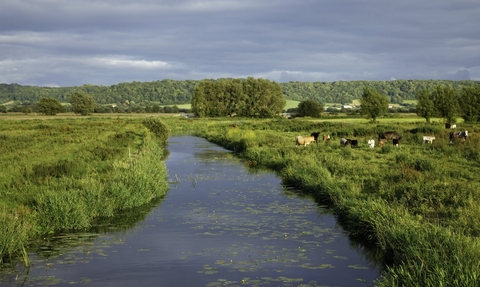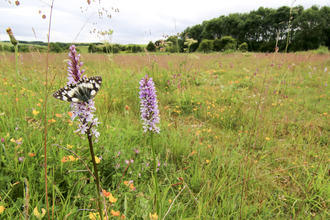
Sowy River and King's Sedgemoor in early summer, Greylake, Somerset Levels, Somerset, England, UK - Guy Edwardes/2020VISION
Nutrient Neutrality with The Wildlife Trusts
Leaving our waterways in better condition after development
In 27 river catchments across England, new developments that include toilets must ensure ‘Nutrient Neutrality.’ This means they cannot increase the amount of nutrients entering local water systems compared to pre-development levels. Developers can achieve this by treating nutrients on-site or by purchasing credits that fund land-use changes elsewhere, which help reduce nutrient levels in the catchment.
The Wildlife Trusts in England are leading the way by converting nutrient-rich lands to more sustainable uses and selling the resulting credits to developers. Our approach goes beyond neutrality, using a nutrient negative model, to actively reduce overall pollution in the process, and leave rivers in better condition after development.
Nutrient Neutrality Explained
What is Nutrient Neutrality?
Nutrient Neutrality is a process that allows developers in specific areas to offset the extra nutrient pollution generated by wastewater from new developments.
For any project that includes toilets, developers must balance the added nutrient load by either treating the nutrients on-site or funding land-use changes elsewhere in the area to keep nutrient levels stable.
What is the nutrient negative model?
Nutrient Neutrality ensures that new developments don't increase nutrient levels in a catchment area. However, The Wildlife Trusts follow a nutrient negative model, aiming to reduce nutrients by an additional 5-10% at each site. This approach actively lowers overall pollution, leaving rivers in better condition after development.
Why do we need to reduce nutrients in our watercourses?
None of the rivers in England or Northern Ireland are in good overall health, largely due to pollution from treated and untreated wastewater and agriculture. High levels of nitrogen and phosphorus from farming and sewage are causing eutrophication, where excess nutrients lead to harmful algae blooms. These blooms deplete oxygen and block sunlight, damaging habitats and wildlife.
At river mouths, algae form dense mats that prevent oxygen from reaching animals in the sediment, causing mass die-offs, especially in hot weather. These mats also hinder birds and can smother critical habitats like seagrass beds and saltmarshes, leading to erosion and further ecological damage.
How do Wildlife Trusts deliver Nutrient Neutrality?
The Wildlife Trusts have developed three models to achieve Nutrient Neutrality:
Direct Sales of Nutrient Credits. For example, Hampshire and Isle of Wight Wildlife Trust acquires land, halts nutrient inputs and returns the land to nature. The nutrient credits delivered by the land use change are calculated and sold directly to developers.
Local Authority Schemes. Local authorities charge developers a levy and these funds are used to facilitate the delivery of Nutrient Neutrality credits. The funds collected are granted to landowners and organisations, such as Dorset Wildlife Trust, to change land use and nutrient inputs, either through new acquiring sites (for example Wild Woodbury) or through changing the use or inputs on existing sites.
Natural England’s Land Use scheme. In this model, Natural England acquires credits from landowners or organisations, such as Durham Wildlife Trust, to fund land use change. This can either be on newly acquired sites or on existing sites with known nutrient inputs. The credits are purchased by Natural England under the condition that no nutrients are added and sole/allocated to developments within the catchment. For example, this model is used by the Durham and Dorset Wildlife Trusts, to fund the creation or extension of nature-reserves (see Great North Bog).
In all models, the Trusts not only stop nutrient pollution but also restore the land and deliver nature-based solutions, improving the overall condition of the catchment.
What are the new wastewater treatment requirements for water companies under the Levelling Up and Regeneration Act (LURA) in England?
The Levelling Up and Regeneration Act (LURA) introduces a significant legal requirement for water companies in designated areas across England. By April 1, 2030, these companies must upgrade their wastewater treatment facilities to the highest technically feasible standards. This initiative is set to substantially lower pollution levels in sensitive regions, easing the environmental impact of housing developments and reducing the mitigation measures needed by developers.
A detailed list of the treatment works identified for upgrades has been released, outlining both the timeline for these enhancements and the anticipated demand for permanent and temporary solutions.
The various upgrades are due to be undertaken between 2025 and 2030 and will bring wastewater treatment plants up to the ‘TAL’ (Technically Achievable Limits) for Nitrates and / or Phosphates depending upon the catchment. This should reduce much of the pollutant load and over time the requirements for nutrient neutrality credits will reduce in each catchment after the upgrade(s).
Case study: The Great North Fen
Durham Wildlife Trust has acquired the Mordon Carrs as part of Natural England’s Nutrient Mitigation Scheme. This exciting project is part of the wider Great North Fen, a historically rich fenland along the River Skerne floodplain and within the River Tees catchment. The project will manage nutrient levels, restore wetland habitats for biodiversity and carbon sequestration, and promote natural flood management.


